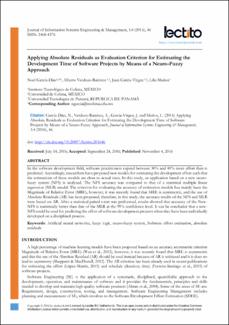| dc.contributor.author | García-Díaz, Noel | |
| dc.contributor.author | Verduzo-Ramirez, Alberto | |
| dc.contributor.author | Garcia-Virgen, Juan | |
| dc.contributor.author | Muñoz, Lilia | |
| dc.date.accessioned | 2017-10-31T19:01:42Z | |
| dc.date.accessioned | 2017-10-31T19:01:42Z | |
| dc.date.available | 2017-10-31T19:01:42Z | |
| dc.date.available | 2017-10-31T19:01:42Z | |
| dc.date.issued | 11/04/2016 | |
| dc.date.issued | 11/04/2016 | |
| dc.identifier | http://lectitopublishing.nl/Article/Detail/JS3LI98L | |
| dc.identifier.issn | 2468-4376 | |
| dc.identifier.uri | http://ridda2.utp.ac.pa/handle/123456789/2915 | |
| dc.identifier.uri | http://ridda2.utp.ac.pa/handle/123456789/2915 | |
| dc.description | In the software development field, software practitioners expend between 30% and 40% more effort than is predicted. Accordingly, researchers have proposed new models for estimating the development effort such that the estimations of these models are close to actual ones. In this study, an application based on a new neuro-fuzzy system (NFS) is analyzed. The NFS accuracy was compared to that of a statistical multiple linear regression (MLR) model. The criterion for evaluating the accuracy of estimation models has mainly been the Magnitude of Relative Error (MRE), however, it was recently found that MRE is asymmetric, and the use of Absolute Residuals (AR) has been proposed, therefore, in this study, the accuracy results of the NFS and MLR were based on AR. After a statistical paired t-test was performed, results showed that accuracy of the New-NFS is statistically better than that of the MLR at the 99% confidence level. It can be concluded that a new-NFS could be used for predicting the effort of software development projects when they have been individually developed on a disciplined process. | en_US |
| dc.description.abstract | In the software development field, software practitioners expend between 30% and 40% more effort than is predicted. Accordingly, researchers have proposed new models for estimating the development effort such that the estimations of these models are close to actual ones. In this study, an application based on a new neuro-fuzzy system (NFS) is analyzed. The NFS accuracy was compared to that of a statistical multiple linear regression (MLR) model. The criterion for evaluating the accuracy of estimation models has mainly been the Magnitude of Relative Error (MRE), however, it was recently found that MRE is asymmetric, and the use of Absolute Residuals (AR) has been proposed, therefore, in this study, the accuracy results of the NFS and MLR were based on AR. After a statistical paired t-test was performed, results showed that accuracy of the New-NFS is statistically better than that of the MLR at the 99% confidence level. It can be concluded that a new-NFS could be used for predicting the effort of software development projects when they have been individually developed on a disciplined process. | en_US |
| dc.format | application/pdf | |
| dc.language | eng | |
| dc.language.iso | eng | en_US |
| dc.publisher | Journal of Information Systems Engineering & Management | en_US |
| dc.publisher | Journal of Information Systems Engineering & Management | |
| dc.rights | https://creativecommons.org/licenses/by-nc-sa/4.0/ | |
| dc.rights | info:eu-repo/semantics/openAccess | |
| dc.subject | Artificial neural networks | en_US |
| dc.subject | fuzzy logic | en_US |
| dc.subject | neuro-fuzzy system | en_US |
| dc.subject | Software effort estimation | en_US |
| dc.subject | absolute residuals | en_US |
| dc.subject | Artificial neural networks | |
| dc.subject | fuzzy logic | |
| dc.subject | neuro-fuzzy system | |
| dc.subject | Software effort estimation | |
| dc.subject | absolute residuals | |
| dc.title | Applying Absolute Residuals as Evaluation Criterion for Estimating the Development Time of Software Projects by Means of a Neuro-Fuzzy Approach | en_US |
| dc.type | info:eu-repo/semantics/article | |
| dc.type | info:eu-repo/semantics/publishedVersion | |
